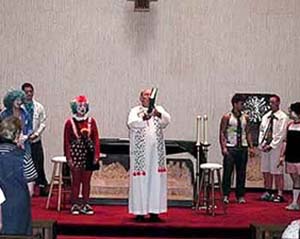 |
Above, a "Clown Mass" that took place in Pleasant Hill, California. A mockery against the sanctity of the Mass. Below, the Tridentine Mass as it was before Vatican II. A striking contrast. |
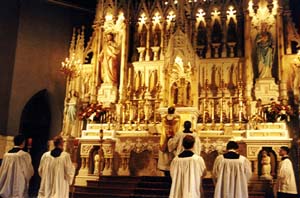
|
T
he Post-Conciliar Liturgical RevolutionOn the
Question of Liturgical Dancing and other abominations
By Kathleen Willet Redle, M.F.A.
"Pope
Gelasius in his ninth letter (chap. 26) to the bishops of Lucania condemned the
evil practice which had been introduced of women serving the priest at the
celebration of Mass. Since this abuse had spread to the Greeks, Innocent IV
strictly forbade it in his letter to the bishop of Tusculum: 'Women should not
dare to serve at the altar; they should be altogether refused this ministry.' We
too have forbidden this practice in the same words...."
--Pope Benedict XIV,
Encyclical Allatae Sunt, July 26, 1755
I
There are some who feel insulated from the liturgical Conciliar Church
Revolution. There are also those within the conservative establishment who
object to the word “conciliar” or “post-conciliar” thinking it is a word created
by Catholic traditionalists. Little do they realize that it was first introduced
by one of the leading mutineers at Vatican II.
The Revolution Within Identifies Itself
For evidence that the post-Vatican II fathers call themselves "conciliar" and
that they recognize there is a crisis in the Church, here is a statement by Fr.
Henri De Lubac, S.J. made at the Institute of Renewal in the Church at Toronto
in 1967:
This is rather odd given the fact that he was himself the chief proponent of the false "new theology" and its pathetic prophet Teilhard de Chardin. He was under censure during the pontificate of Pope Pius XII."It is clear that the Church is facing a grave crisis. Under the name of ‘the new Church,’ ‘the post-conciliar Church,’ a different Church from that of Jesus Christ, is now trying to establish itself; an anthropocentric society threatened with immanentist apostasy which is allowing itself to be swept along in a movement of general abdication under the pretext of renewal, ecumenism or adaptation."
Above, a "Clown Mass" that took place in Pleasant Hill, California. A mockery against the sanctity of the Mass.
Below, the Tridentine Mass as it was before Vatican II.
A striking contrast.

"The Church of the Council... has also, it is true, been much concerned with man, with man as he really is today, with living man …. we also more than anyone else, have the cult of man."Paul VI made no effort to hide universal salvation in his closing remarks, stating:
"How could it be otherwise if this council was said to be and is ecumenical, that is to say, universal? Just as the sound of the bell goes out through the skies, reaching each one within the radius of its sound waves, so at this moment does our greeting go out to each and every one of you. To those who receive it and to those who do not, it resounds pleadingly in the ear of every man. From this Catholic center of Rome, no one, in principle, is unreachable; in principle, all men can and must be reached. For the Catholic Church, no one is a stranger, no one is excluded, no one is far away. Every one to whom our greeting is addressed is one who is called, who is invited and who, in a certain sense, is present. This is the language of the heart of one who loves. Every loved one is present!Universal salvation? Is that possible in light of Our Lord's command (Mark 16: 15-16)? Not if one believes salvation can only come through the one true Church outside of which there is no salvation - Extra Ecclesiam nulla salus. All other efforts to rationalize salvation are non-Catholic, and yet that is what has been forced on civilization for the past 40 years. The great conspiracy has penetrated every facet of society, but especially within the Church and, more specifically in the liturgy where novelty has taken over.
“And we, especially at this moment, in virtue of our universal pastoral and apostolic mandate, we love all, all men. Hence, we say this to you good and faithful souls who, absent in person from this gathering of believers and of nations, are here present in spirit with your prayer. The Pope is thinking of you too, and with you he celebrates this sublime moment of universal communion” (Closing Address by Paul VI).
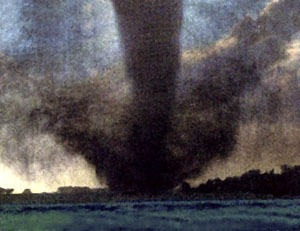 |
|
Even the conservative Fr. Brian Harrison affirmed his dismay in an titled “A Loyal Son Protest, Can a Loyal Catholic Ever Criticize the Pope?” :"On that day .... I walked through Assisi .... and I saw real profanations in some places of prayer. I saw Buddhists dancing around the altar upon which they placed Buddha in the place of Christ and then incensed it and showed it reverence. A Benedictine protested and the police took him away .... There was obvious confusion in the faces of the Catholics who were assisting at the ceremony" (30 Days, November 1990, p. 64).
Above, John Paul II greets an African voodoo "priest" at the ecumenical encounter at Assisi, 1986.
Below, JPII in front of the Portiuncula at Assisi pursues his dream of being the head of a pan-religion. He stands as an equal with leaders of the false creeds.
"These agonizing question have been presenting themselves increasingly in recent years .... to people who like myself do not consider themselves in any way dissenters .... (then Fr. says he teaches at the Pontifical University) .... I am dismayed at the January 24 inter-religious peace gathering in Assisi. It is well-known that before the first such gathering in 1986, which played no small part in provoking the rupture between Archbishop Lefebvre and the Holy See in 1988, a number of Cardinals privately warned John Paul II of the imprudence of such an innovation - utterly unheard of in 2,000 years of Church History. Their concern was shared by thousands of faithful priests, religious and Catholic laity. Perhaps if we had publicly voiced that concern, instead of remaining silent out of fear and human respect, His Holiness might have felt the need for greater restraint in the next millennium. Despite certain precautionary nuances against syncretism .....Then Fr. Harrison goes on to say that the “Pontiff invites Jewish, Islamic, pantheistic and polytheistic religious leaders to come and practice their respective form of worship inside Catholic churches religious houses,” that Catholics see nothing wrong with that view and are “lapsing gradually into Naturalism and Atheism” (as Pope Pius XI stated). So we can see this Naturalism at work with ICEL and the USCCB who want to bring on the “fancy dancers.” (ibid).
“The practical effect in the minds of millions of observers worldwide can only have been to create or reinforce the impression that the Roman Catholic Church now endorses what Pope Pius XI described as ‘the view that all religions are more or less good and praiseworthy....’”(Inside the Vatican, May 2003).
“If the story was accurate to intend to turn Fatima into an inter-religious, ‘center where all the religions of the world gather to pay homage to their various gods,’ then I condemn such a project as contrary to Sacred Scripture, Sacred Tradition and the whole spiritual message of Our Lady of Fatima, who called instead for the conversion of sinners and the consecration of Russia, not the honor of false gods and the promotion of false religions.”To those who might doubt this is where the ecumenical progressivists are headed, I invite you to read from the various documented articles available at The Fatima File website.
 |
|
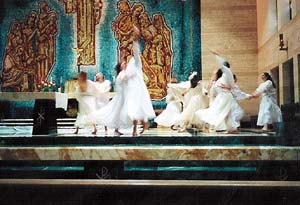 |
|
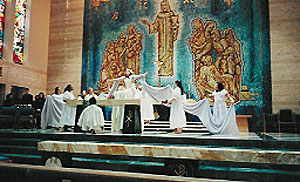 |
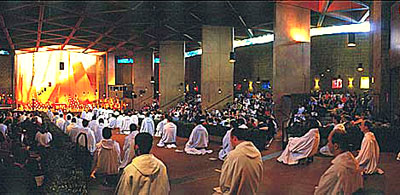 |
|
“The intention of Pope Paul VI with regard to what is commonly called the Mass, was to reform the Catholic Liturgy in such a way that it should almost coincide with the Protestant liturgy. ... There was with Pope Paul VI an ecumenical intention to remove, or at least to correct, or at least to relax, what was too Catholic in the traditional sense, in the Mass and, I repeat, to get the Catholic Mass closer to the Calvinist mass...”
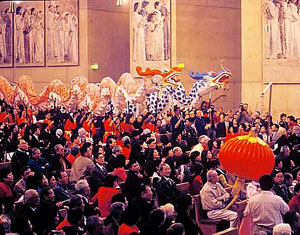 |
|
The Chinese pagan ritual of opening a new year was enacted during a Mass at the Los Angeles Cathedral. What next? |